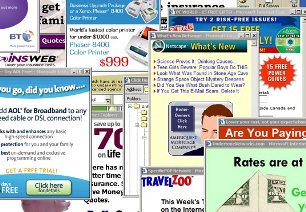Hi all, Blake Ross here. Alex asked me to guest write a post this week because he's a fan of the Firefox project, which I cofounded. Before Firefox, I worked at Netscape throughout high school on its 6.x and 7.x releases. It was my first experience in a professional programming shop. I'm writing this now from my therapist's couch.
It's hard for me to write a WTF, not because I can't remember one, but because I remember too many. Netscape was one giant WTF, or as they called it back then, AOL. The company had grown so inept that "WTF" became just another thing we said each day, like "Hey" or "What time is it?" or "We just lost another 5%" or "Marketing wants to replace the Back button with an ad for Bowflex". In fact, as I'm sure you know, the Mozilla movement itself was born when Jim Barksdale looked at the old Netscape 4.x codebase and announced, with tremendous gusto and wondrous pride: WTF?
I've been reading this site since its inception and seen most of the classic coding errors. There are a few doozies I could share -— a Netscape engineer who shan't be named once passed a pointer to JavaScript, stored it as a string and later passed it back to C, killing 30 —- but most are what I call "nested WTFs." The surrounding code is so equally offensive that you'd have to understand all of it before finally experiencing the epiphany of The One True WTF. Such experiences, therefore, are best left to ABC miniseries.
 If you'll indulge me, I will instead share a poor product decision made about Netscape 7, and that is: it was released. More importantly, it was released without popup blocking, an egregious mistake given that:
If you'll indulge me, I will instead share a poor product decision made about Netscape 7, and that is: it was released. More importantly, it was released without popup blocking, an egregious mistake given that:
- Popups dominated the Web in 2002.
- No major consumer browser blocked them natively.
- Mozilla 1.0 did, and that release was the basis of Netscape 7.
AOL ordered us to cut popup blocking because its web properties, especially Netscape.com, relied on the advertising format. Such is the life of an engineering organization which must design a browser for 20 billion websites and then optimize it for one of them. (See also: theming the browser to integrate seamlessly with that site while clashing savagely with all others.)
So Mozilla 1.0 came out in June with popup blocking, and Netscape 7 came out six months later without it, but offered, as consolation, 12 AOL icons on your desktop. Technology reviewers who understood the Netscape/Mozilla relationship did not miss the fact that Netscape went to additional trouble to remove popup blocking. To put it another way, all Netscape had to do to release one of the most compelling browser features in years was: nothing. They still managed to mess up for reasons I haven't yet figured out. During my tenure at Netscape, I sat through more meetings than we had users, throughout which people seemed very good at doing nothing.
Fortunately, AOL management got the picture after c|net, in flagrant violation of marketing's press kit, slammed the release for omitting the blocker. To make things right, Netscape quickly released a version 7.01 that included it, but only after renaming it the "popup suppressor" ("popup decongestant" was trademarked).
Unfortunately, the release also contained a feature called the "popup suppression whitelist." This was a list of sites that were still allowed to open popups, and it was seeded with all of the AOL properties that used them, such as Netscape.com.
By the way, Netscape.com was the default homepage.
Now back to my therapy, already in progress: When dozens of people eagerly fired up the New Netscape 7.01, Now With Popup Blocking!, the very first thing they saw was a popup ad. WTF?
* Much has changed since these glorious years. For instance, Netscape now adds only 7 AOL icons to your desktop. But also, Netscape.com no longer has a popup ad. You can still download Netscape 7.01, turn on "popup suppression" and change your homepage to CNN to relive the magic.

